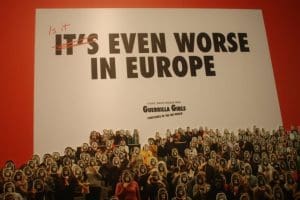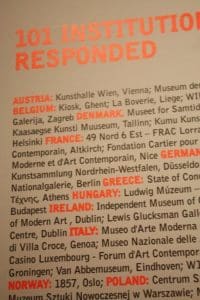
Guerrilla Girls ‘Frida Kahlo’ and ‘Käthe Kollwitz.’
Guerrilla Girls are hosted by Whitechapel and Tate Modern in battle against sexism
By James Brewer
Feminist guerrillas in gorilla garb are in London to hold to account the contemporary arts world in Europe – and by extension its American and global manifestations – for discriminatory and mercenary practices.
The anonymous activists Guerrilla Girls have been given space at two of the capital’s leading galleries, Whitechapel and Tate Modern, to expound a new facet of their long-running – three decades – campaign for full recognition of the contribution women make to the arts.

Guerrilla Girls ‘conscience of the world.’
The ‘girls’ are more than mere critics, They are a ‘happening’ and ‘installation’ in themselves. Their venues turn into Guerrilla galleries.
For public appearances, the Guerrilla Girls don gorilla masks and two of the movement’s founders who take on the pseudonyms of Frida Kahlo and Käthe Kollwitz have been at the famed London institutions. The names are of outstanding heroines in 20th century art: Frida Kahlo (1907-54) a Mexican who challenged female oppression and championed native culture, and Käthe Kollwitz (1867-1945) a German sculptor whose work bitterly condemned war and oppression.

Whitechapel Gallery Guerrilla Girls Commission: Is it even worse in Europe?
(2016). Photo: David Parry/PA Wire.
It was a bizarre first for the in-character guerrillas to go on stage at the Whitechapel auditorium to address a press conference of some 50 journalists unsure of how the duo would vocalise their themes; and the following day for them to address a curious public at the same venue about the group’s many years of activism.
Soft and pleasing American accents flowed through the gorilla headpieces, but the message was acerbic and fortified by the results of a survey they had conducted in summer 2016. The Guerrilla Girls wrote to the directors of nearly 400 old and new galleries that host contemporary displays, posing 14 questions about exhibitions, budgets and efforts on gender and geographic diversity. The answers, and in the majority of cases lack of response, have been made public under the rubric Is it even worse in Europe? the title of the show commissioned by and launched on Oct 1 2016 at the Whitechapel.
It was a revisiting of the 1986 Guerrilla Girls’ campaign It’s Even Worse in Europe. They remain angry about the growing “power of the wealth of a few” and “overheated art market” encroaching on the way art serves its audience. They received 101 replies to their questionnaire.

Guerrilla Girl snaps back.
‘Käthe Kollwitz’ said that in America, but increasingly in other places, very rich collectors were opening their own museums which they could completely control. This heightened the amount of “bad behaviour of multinational collectors who are kings of the world and oligarchs.” European museums were different: many were public, run by governments, but privatisation was a creeping problem. “Can we allow this system to deliver us our history? We want to ask this question,” ‘Käthe Kollwitz’ said.
She added: “How can they deliver the history of a global culture with only the work of white men?” The perception in places had changed, “but there will probably still be a lot of art collectors who still believe that.”
The Guerrilla Girls said that their project posed the question: “Are museums today presenting a diverse history of contemporary art or the history of money and power?” Art could not be reduced to the small number of artists who have won a popularity contest among big-time dealers, curators and collectors. “Unless museums and Kunsthallen show art as diverse as the cultures they claim to represent, they are not showing the history of art, they are just preserving the history of wealth and power.”

From list of institutions which responded.
A banner has been installed on the street façade of the Whitechapel, lamenting low level of feedback to the survey. Copies of every completed questionnaire, some typed and others hand-written, have been posted on one wall in the Whitechapel’s Archive Gallery. The questions relate to the number of artists in recent exhibitions who are female, gender non-conforming or from Africa, Asia, South Asia and South America.
The Guerrilla Girls say on their website: “We’re feminist masked avengers in the tradition of anonymous do-gooders like Robin Hood, Wonder Woman and Batman. How do we expose sexism, racism and corruption in politics, art, film and pop culture – with facts, humour and outrageous visuals.”
‘Käthe Kollwitz’ said that more than 55 people have been members of the Guerrilla Girls over the years, but operating in small groups at any one time suited the type of work they did. ‘Frida Kahlo’ said: “Artists in general love us, gallery directors are curious, dealers wish we would go away. That is fine by us, because we do not produce a product they can fetishise and turn into a valuable thing.”

Some that declined to reply.
In the last several years, the members of the collective have appeared at more than 90 universities and museums, and gathered a good deal of press coverage. They have written books including The Guerrilla Girls’ Bedside Companion to the History of Western Art and Bitches, Bimbos and Ballbreakers: The Guerrilla Girls’ Guide to Female Stereotypes. One of their most famous posters bears the legend: “Do women have to be naked to get into the Met Museum?” They are part of the Amnesty International Stop Violence against Women campaign in the UK.
Ten new posters feature at the Whitechapel, listing all the museums that responded, plus statistics, analysis, and extracts from the replies of the various museum directors. In a floor panel are the names of the museums which did not give detailed responses to the questionnaire.“Feel free to walk on them. Love, Guerrilla Girls” says an accompanying written comment.
The list on the floor includes, for instance from Greece, DESTE Foundation for Contemporary Art, Radio Athènes and iset, Athens; and Centre for Contemporary Art, Macedonian Museum of Contemporary Art, and State Museum of Contemporary Art, Thessaloniki.
Dakis Joannou from DESTE wrote: “It is not the gender that makes a good artist. It is TALENT… A collector will not ignore a good artist whether she is a woman or another nationality or another sexual orientation. Talented women artists are not ignored anymore.”

Poster from 2012. Courtesy the Guerrilla Girls.
Institutions which did reply included – again, for instance from Greece – State of Concept, and National Museum of Contemporary Art, both in Athens. Liana Fokianaki, founder and director of State of Concept, said that in its three years of operation, “six of our eight solo shows have been of women.” Katerina Koskina of the National Museum of Contemporary Art, Athens, said: “Women artists represent about 30% of our permanent collection.”
The host galleries in London appear to be in the good books.
Frances Morris, director of Tate Modern, said that of contemporary (living) artists in the Tate collection 35% are women (a total of 335 women). “The gap has narrowed in recent years.”

Dear Art Collector. 2015. Courtesy the Guerrilla Girls.
Iwona Blazwicz, director of Whitechapel, said: “We have exhibited 21 female solo show artists between 2011 and 2015.” The best attended event was the Hannah Hoch exhibition from January to March 2014 which received 88,980 visitors. From the Baltic Centre for Contemporary Art, Gateshead, Sarah Munro reported that 19 women had one-person shows over the past five years.
Coinciding with the Whitechapel commission and exhibition, the Guerrilla Girls lead a week-long public project at Tate Modern from Oct 4-9, as part of Tate Exchange.
Guerrilla Girls: Is it even worse in Europe? is curated by Nayia Yiakoumaki of Whitechapel Gallery and Xabier Arakistain, who lives and works in Bilbao. Ms Yiakoumaki said that the institutions knew that if they did not respond to the Guerrilla Girls’ questions they would still be part of the current show. The questions were quite demanding, she admitted: someone would have to do their homework to find the answers as art gallery professionals would not normally think of all the points raised.
‘Käthe Kollwitz’ said they started the survey partly as a statistical exercise but “this was not really a scientific survey.” The answers were “sometimes ridiculous, sometimes fantastic, sometimes were not even truthful.”
‘Frida Kahlo’ concurred: “We are not social scientists, we are campaigners, and our work is always trying to transform the system. Rather than saying ‘just pull your fingers out’ saying this [situation] is bad, we have always wanted to create a dialogue. That is one of the best outcomes we can have.”
“Hopefully over the years our critique has deepened,” observed ‘Käthe Kollwitz.’ Asked if things had improved since the movement began 31 years ago, she said: “Definitely there is more diversity. When we started out it was unusual for a gallery to have any women, or artists of colour. In the early days we had to present the issue in a way that people could not deny that this was happening.”
Supporters of the Whitechapel exhibition are New Hall Art Collection, Murray Edwards College, University of Cambridge, Etxepare Basque Institute, Valeria Napoleone XX, and Omni Colour,.
Guerrilla Girls: Is It Even Worse in Europe? is at Whitechapel Gallery, 77 – 82 Whitechapel High Street, London E1 until March 5 2017. Entry is free





